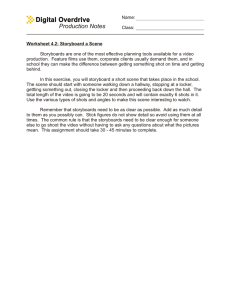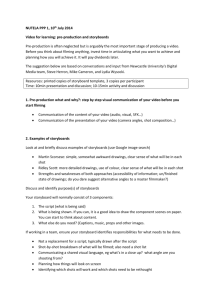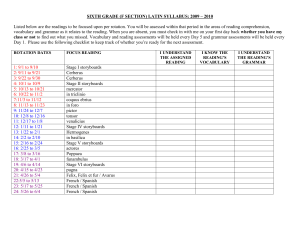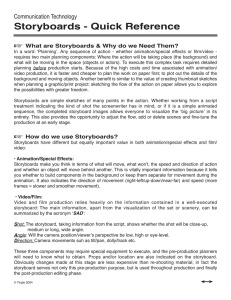CS160 Discussion Section Feb 27 2007 David Sun
advertisement
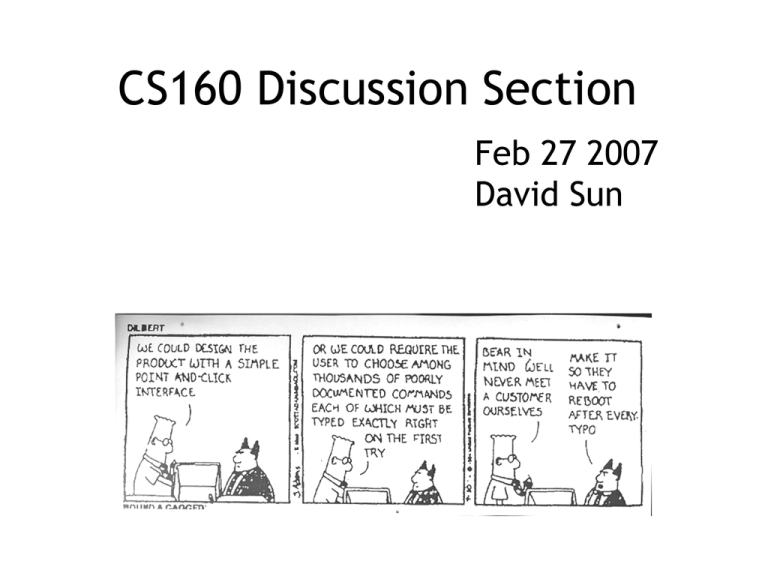
CS160 Discussion Section Feb 27 2007 David Sun Rapid Prototyping • Interface builders can easily show the look-andfeel of a design but requires considerable programming effort to get it to work and to show the behavior (flow) of the interaction (see Tiny Fingers paper). • What are some of the problems with paper (low-fi) prototyping? – Hard to store, search, modify. – Not really interactive (user must play the computer) SILK • A sketch interface for illustrating interface behaviors during early stages of interface design. • Storyboards: a sequence of sketches of the application's interface state to illustrate application's behavior in response to enduser actions. – The focus is on behavior, flow, metaphor rather than implementation details. SILK (Cont’) • Basic notation: – Screen: a sketch of the interface in a particular state. – Arrows: connecting two screens. Source is the component the end-user interacts with by clicking to bring the screen to the destination. • Storyboard model constructs a tree (graph) representation of the program. Not the entire tree needs to be constructed since the focus is on key sequences. Video of SILK DENIM DENIM VIDEO Storyboards (review) • Tell the user’s experience of completing their tasks • Series of frames depicting key steps in reaching the user’s goal – Can use a pin board for easy rearrangment/editing • It’s about the user, not the equipment Storyboards (more review) • Describe the interaction context – Useful to show user in at least 1st frame (establishing shot) – Show relationship between the user and the environment – Show relationship between the user and the system • A series of actions or operations toward a goal – Choose the goal – Plan ordered set of actions to achieve the goal – Depict each action and outcomes Examples • http://vis.berkeley.edu/courses/cs160fa06/WWW/lecturesWWW/sketchingstoryboarding/walk028.html • http://vis.berkeley.edu/courses/cs160fa06/WWW/lecturesWWW/sketchingstoryboarding/walk031.html • http://vis.berkeley.edu/courses/cs160fa06/WWW/lecturesWWW/sketchingstoryboarding/walk033.html Uses • Communication and visualization – Large amount of info or sequence of events – Motion and mechanisms • Brainstorming – Solving complex problems; exploring alternatives • Planning – Like planning in detail what to film – Forces designer to think through the possible outcomes with the design Shots • Wide – taken from a long way away – people look quite small in this kind of shot – can see what sort of place the scene is set in • Long – closer than a wide shot – can see the person from head to toe – can still see what's around them http://www.mediaed.org.uk/post ed_documents/Storyboarding.ht More shots • Medium – from just below their waist to just above their head – close enough to see people's expressions – can see what they are doing with their hands as well • Close-up – shows just the head of the person – use when it's important to see someone's expression Example: Yahoo • http://kevnull.com/presentations/iasu mmit2006/iasummit.swf Exercise • Storyboard your interface and one of your tasks – think about – think about system – think about – think about outcomes the user and goal the environment and your the steps the initial state and the Administrivia • Please create a webpage for your project so I can link it to the course site. – Project submissions – Supplemental material • Please ANONYMIZE the contextual inquiry subjects in your reports.
